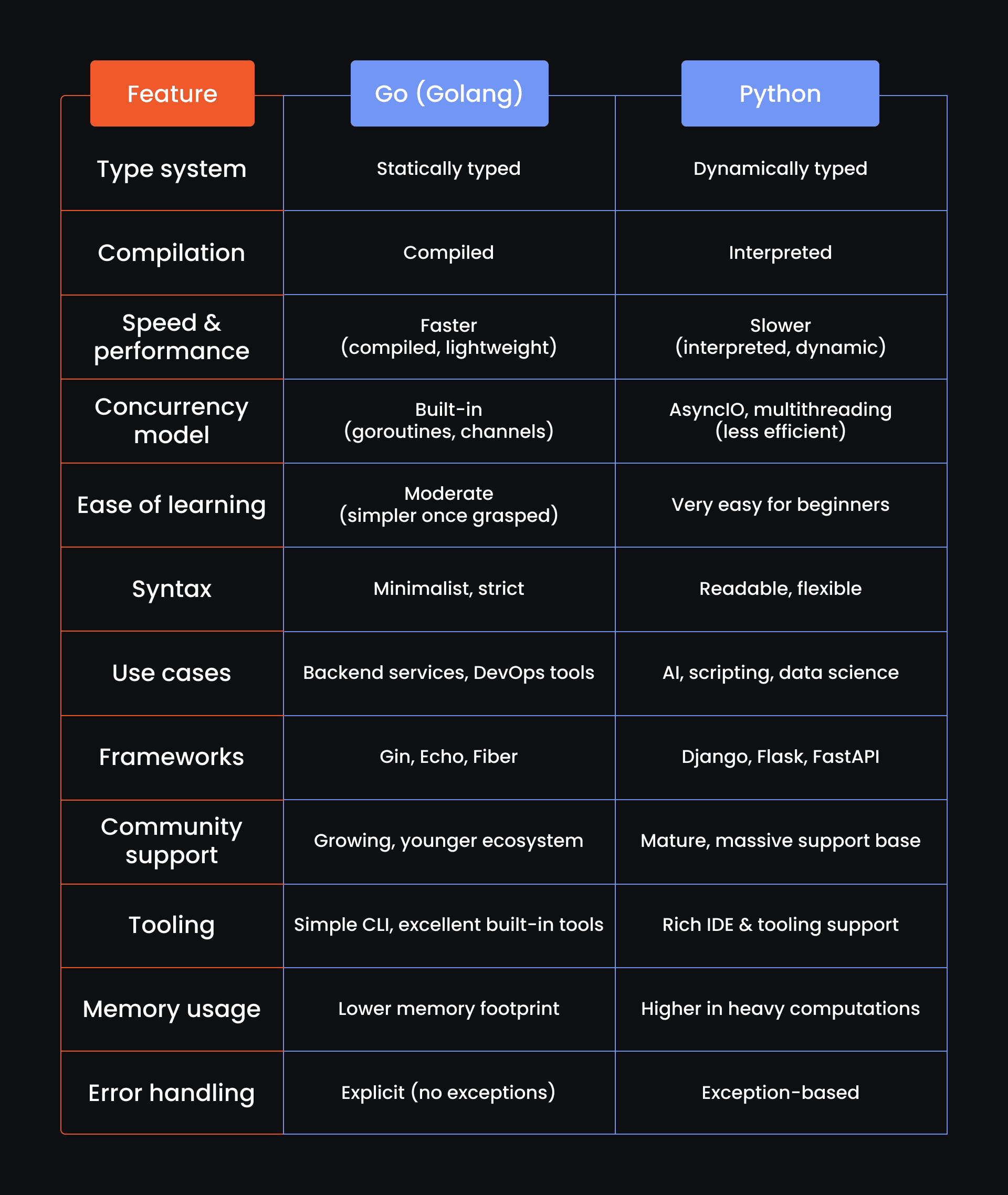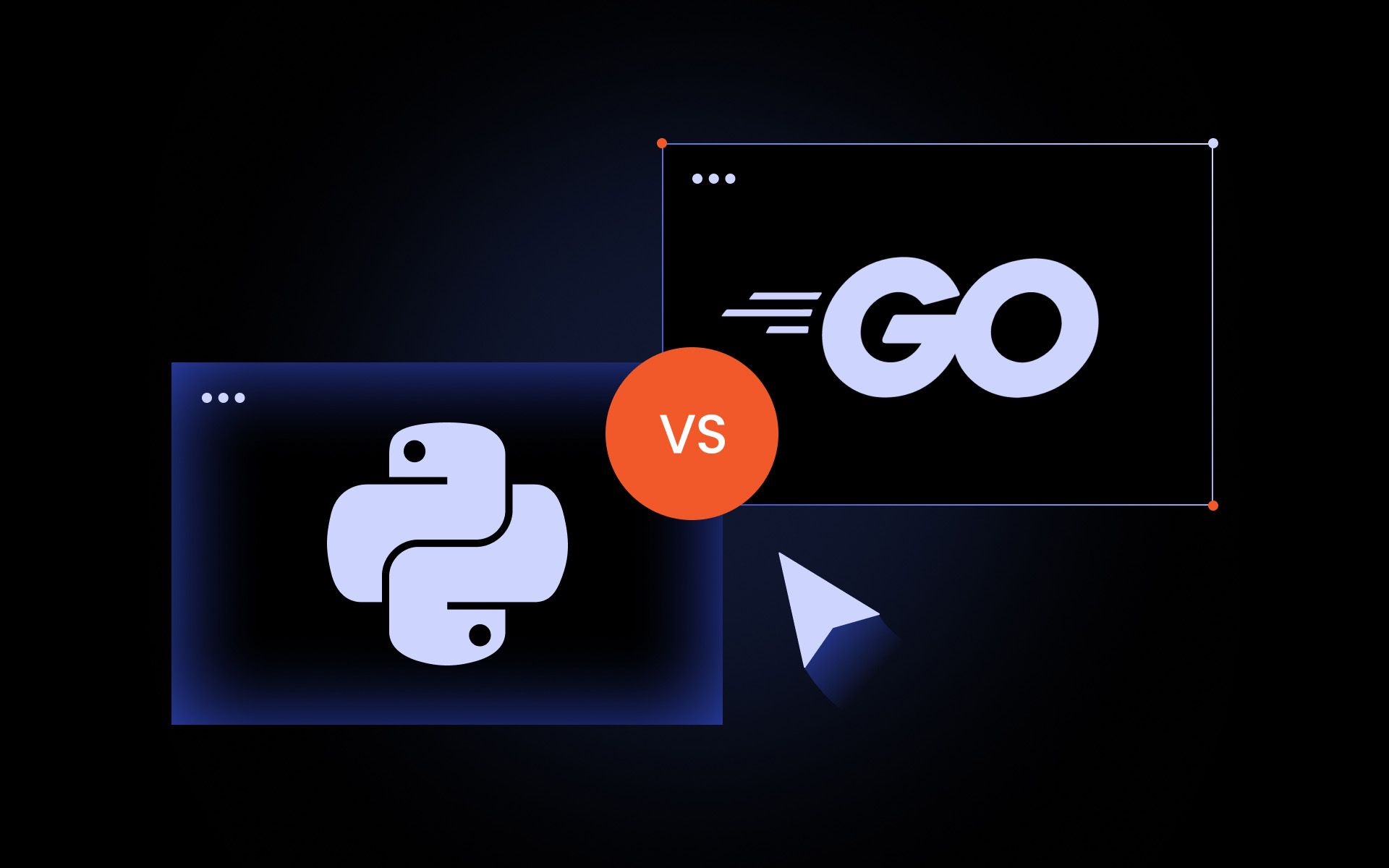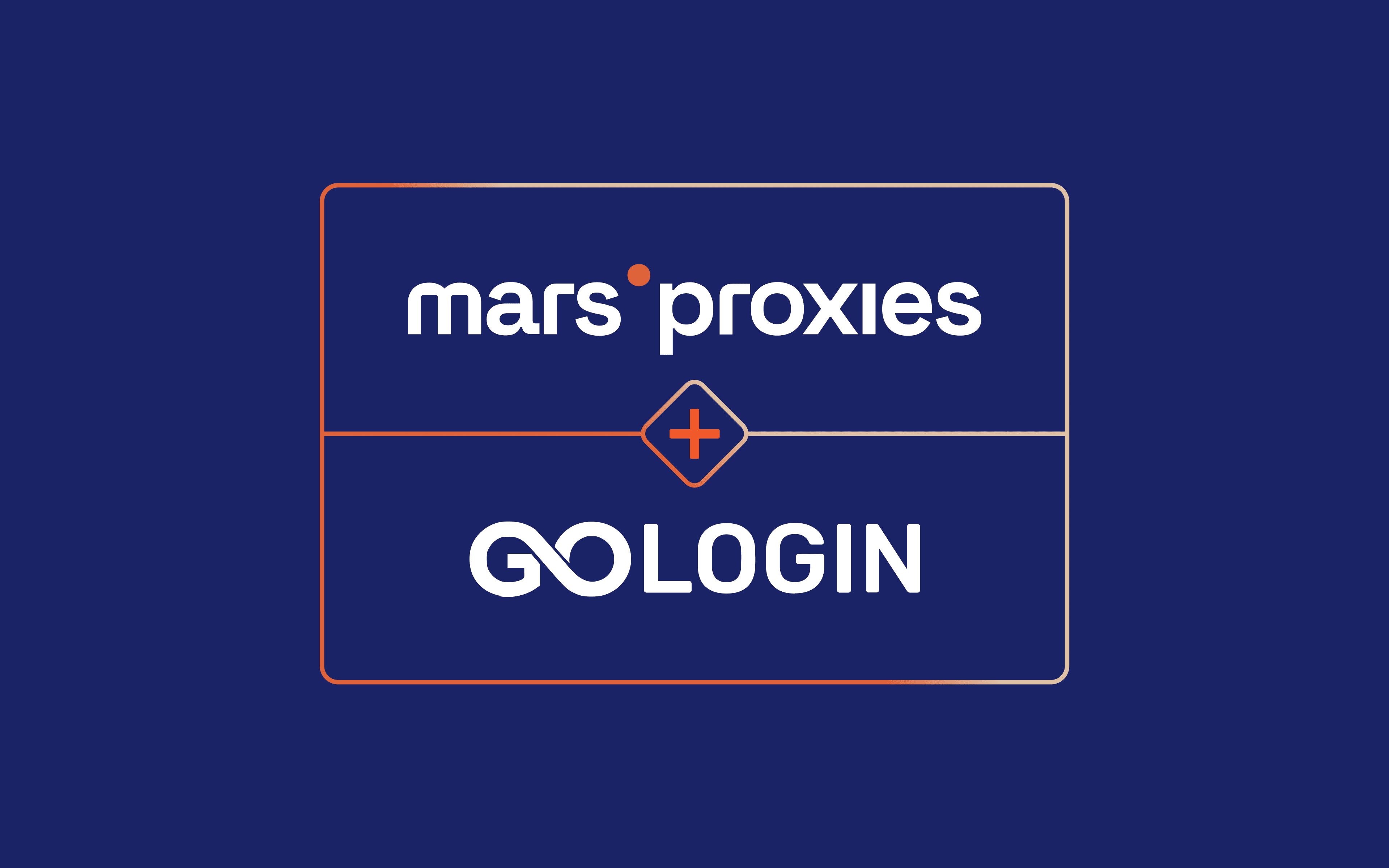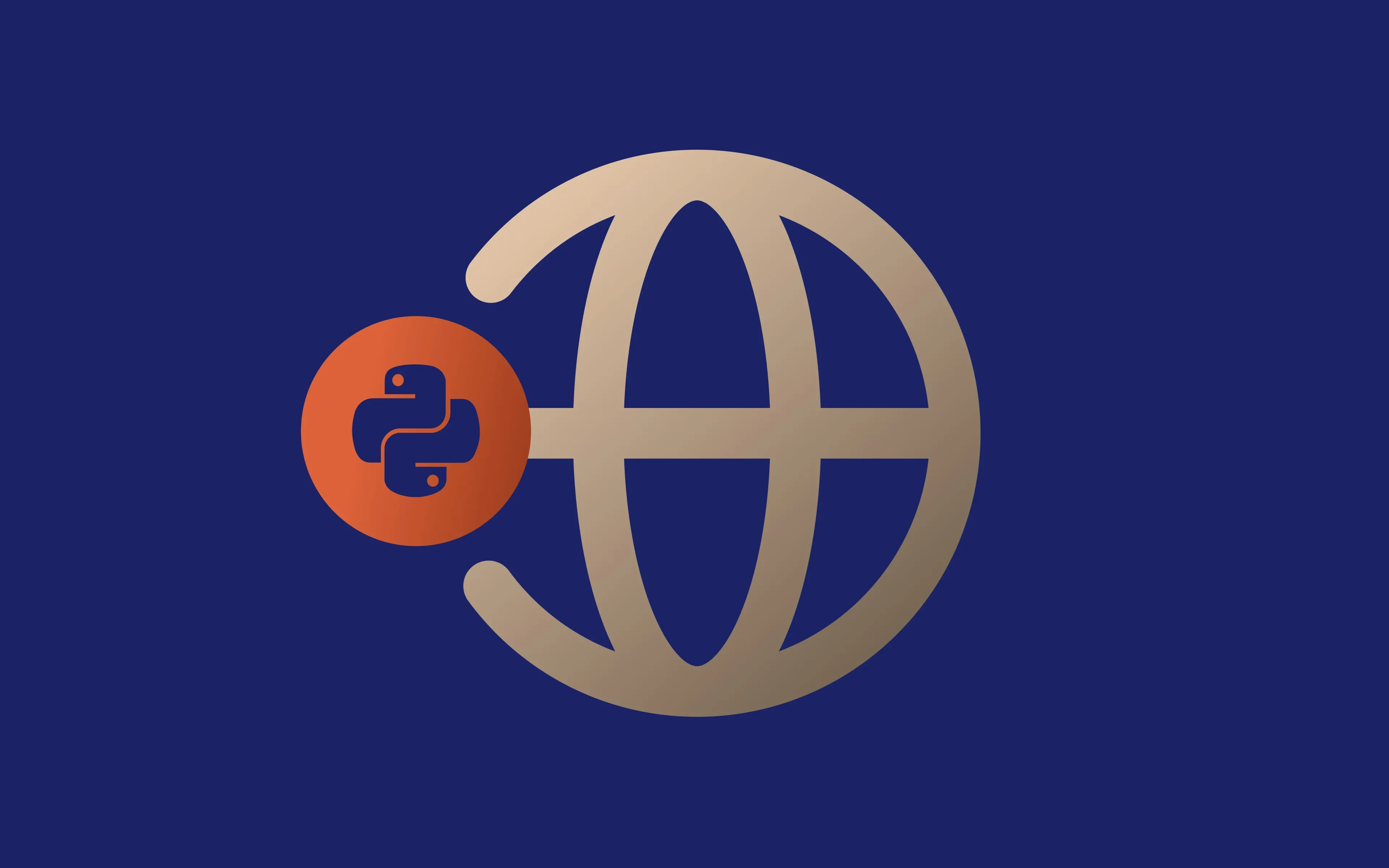When it comes to choosing a programming language in 2025, two contenders often come up: Go vs Python. Both are powerful programming languages, but they serve different purposes and have different strengths. Whether you're diving into web development, machine learning, or building web applications, understanding the key differences between Go and Python can help you make an informed decision.
Let's dive into their unique traits, use cases, and how they stack up against each other.
What is Go (Golang)?
Go, or Golang, is an open-source programming language created by the folks at Google. It is designed for performance and efficiency making it particularly eye-catching for engineers who are focused on building massive, high-throughput systems. Since it is a statically typed language, it ensures type safety at the time of compilation, thus reducing bugs and improving overall code clarity in humongous codebases.
It boasts simple syntax that encourages readable code and discourages ridiculously complex constructs. This leads to cleaner and way more maintainable applications. Go excels in memory management through a garbage collector that’s optimized for low-latency workloads, and, besides that, its modern dependency management system is based on modules, which greatly simplifies versioning and package control.
With a native capability to write concurrent programs via goroutines and channels, developers of various skill levels can build scalable applications without having to rely on third-party concurrency models. In this regard, Go is an excellent fit not only for cloud computing (which happens to be incredibly popular right now) and DevOps tools, but also for containerized environments, distributed systems, and real-time web applications – all things where speed, efficiency, and scalability are as important as they can be.
What is Python?
Python, on the other hand, is a dynamically typed language that is well-known for its simplicity and readability, making it incredibly popular among both beginners and experienced developers. It is a so-called interpreted language, which means that the code is executed directly, skipping the compilation step, thus allowing for quick iteration and testing.
Python has a huge ecosystem of its own that contains libraries and frameworks, particularly strong in fields like scientific computing, data science, machine learning, and data analysis. With packages like NumPy, Pandas, SciPy, and Scikit-learn, Python provides a comprehensive suite for data-heavy applications.
Besides these perks, the Python interpreter executes Python programs on a line-by-line basis, offering flexibility during development and easier debugging. Python’s intuitive syntax and high-level abstractions make it highly beginner-friendly, often being the first programming language taught in schools and bootcamps, as well as usually recommended as the first choice for beginners by professional developers.
Python also supports object-oriented programming principles, promoting code reuse and modularity. It is often applied for web development with frameworks like Django and Flask, web scraping, automation, scripting, and rapid prototyping across pretty much any industry you can think of.
Go vs Python: Key Differences
Obviously, both Go and Python are programming languages with their own quirks, advantages, and disadvantages. The key factors/features to keep in mind when comparing them are these:

Syntax and Readability
When it comes to syntax and overall readability, let’s check some code examples where instead of greeting the world (as is usual in the programming world), we greet the language in use.
Go Example:
package main
import "fmt"
func main() {
fmt.Println("Hello, Go!")
}
Python Example:
print("Hello, Go!")
Python’s simple syntax and minimal boilerplate make it a perfect programming language for beginners. Go, while stricter, promotes clean and maintainable code.
Performance and Speed
Now, who is the winner in this Go vs Python battle then? When raw speed and performance is considered, Go takes the cake due to it being compiled with the Go compiler, which translates the source code into fast, machine-level binaries. With it, Go applications launch quickly and execute with minimal overhead, making it ideal for system-level programming and real-time services.
On the other hand, Python, which is an interpreted language, is oftentimes slower as it relies on the Python interpreter to execute code line by line during runtime. However, keep in mind that Python makes up for this with exceptionally quick development speed, which allows developers to prototype and iterate at breakneck speeds: all thanks to Python’s concise programming language syntax, dynamic typing, and filled-to-the-brim ecosystem of pre-built libraries.
Concurrency and Scalability
Concurrency is the name of the game for Go as it uses goroutines and channels to support concurrency. This means that Go is highly scalable and very efficient for handling hundreds (and even thousands!) of concurrent tasks with minimal overhead. This built-in support for lightweight thread-like processes lets Go programs perform incredibly well in network services, real-time systems, and high-performance APIs. Goroutines are managed by the Go runtime, which efficiently multiplexes them onto operating system threads without any manual interventions.
As for Python, this programming language uses AsyncIO and threads, which are less efficient, thanks but no thanks to the Global Interpreter Lock (GIL), which can limit performance when multiple threads are in use. While AsyncIO offers a non-blocking and accessible programming style, it requires a different coding paradigm and careful design to match Go’s concurrency capabilities.
Use Case Comparison
While both Go and Python seem to have their pros and cons when it comes to pure coding and code adaptation, let’s check some particular use cases to see which one comes out victorious in this hypothetical battle of Go vs Python.
Web Scraping
In web scraping, you might as well say “hail to the king,” which happens to be Python. It has extensive libraries such as BeautifulSoup, Scrapy, and requests. These tools give a helping hand to developers and businesses alike with a powerful and user-friendly approach to automating the process of accessing and extracting web content, whether with residential proxies or other proxy types. Python’s data manipulation capabilities via libraries like Pandas and NumPy make scraping, parsing, storing, analyzing data, and doing anything else related to it an absolute breeze. Just pop in a Python library and you are good to go. Besides that, Python supports robust scheduling and automation frameworks (namely Celery and Airflow) which are priceless for building reliable scraping pipelines.
As for Go, it can scrape, too, but it lacks equivalent high-level tools and community-supported packages. This results in more manual coding and more time wasted in development cycles for tasks that can be done in a snap with Python, making it the loser in the debate of Go vs Python.
Web Development
Website development is not as one-sided as scraping was, as both Python and Go have their moments to shine here. Python has Flask, Django, and FastAPI, which are frameworks with rich features specifically designed for web applications. The features include routing, templating, ORM integration, and robust middleware support. These frameworks are backed by a vast array of various extensions and tools that simplify literally everything, from user authentication to database management. FastAPI is worthy of a separate mention as it is almost a perfect tool for building APIs quickly with automatic Swagger documentation and async capabilities.
As for Go, it has Gin and Echo frameworks that are minimalistic and way faster, as they are focused on speed and simplicity. They provide efficient routing, middleware chaining, and JSON handling, making them ideal for building high-performance backend systems and RESTful APIs that require speed and reliability without heavy dependencies.
Backend Systems & Microservices
It just so happens that Go is purpose-built for microservers and scalable APIs. Does that need further explanation? Alright, maybe it does. Go, due to this actual purpose, is great for developers building modern, distributed systems. Its space management is ridiculously efficient and avoids garbage collection delays that can slow down the performance in high-load environments. Goroutines and channels utilized by Go allow applications to handle thousands of tasks at the same time without the dreaded overhead of traditional threading. Combine that with its simplicity, static typing, and minimal runtime dependencies, and you have incredibly fast Go applications that are not only speedy but have a clear edge over Python in performance in real-time, high-throughput backend infrastructures.
Machine Learning & Data Science
Python dominates with libraries like TensorFlow, PyTorch, scikit-learn, and Pandas, which are widely adopted in academia and industry for everything from research to production-grade systems. Its ecosystem is unmatched in data science, machine learning, and scientific computing, offering seamless interoperability with other tools like Jupyter Notebooks, Matplotlib for visualization, and data manipulation frameworks like Dask. This makes Python the go-to language for building end-to-end machine learning pipelines. Go is gaining ground, especially with emerging libraries such as Gorgonia and GoLearn, but it is not yet a primary choice for AI and ML tasks due to limited tooling, community resources, and available educational content.
Pros and Cons of Each Language
Go Pros:
- High performance
- Easy concurrency with goroutines
- Low memory usage
- Great for cloud-native applications
- Simple deployment (single binary)
Go Cons:
- Smaller ecosystem
- More verbose error handling
- Less beginner-friendly
Python Pros:
- Extremely easy to learn
- Massive python library support
- Ideal for prototyping and AI/ML
- Rich community and documentation
- Great package management
Python Cons:
- Slower runtime
- Not ideal for heavy concurrency
- Higher memory footprint
When to Use Go vs Python (2025 Recommendations)
Best for Scraping
Python – thanks to its powerful scripting language tools and libraries, such as BeautifulSoup, Scrapy, and requests. These libraries provide extensive capabilities for crawling websites, extracting structured information, and managing HTTP requests. Python also supports seamless integration with data analysis tools, allowing scraped data to be cleaned, transformed, and analyzed with minimal effort.
Best for High-Performance Apps
Go – due to its efficient space management, robust concurrency model using goroutines and channels, and compiled nature that enables faster execution and better system-level performance. Go also compiles down to a single binary, simplifying deployment in containerized or cloud-native environments.
Best for Prototyping or AI
Python – excels in data analysis, AI, and rapid development with its rich object oriented libraries and tools. Its intuitive syntax and dynamic typing allow developers to write less code and iterate quickly, which is invaluable during the research or early product stages. In addition to supporting a wide range of machine learning frameworks like TensorFlow and PyTorch, Python integrates smoothly with data visualization and analytics tools, making it an indispensable tool in the AI development pipeline.
Conclusion
Both Go and Python are powerful programming languages with unique strengths. Go is best for concurrent programming, scalable backend services, and cloud-based microservices. Python is unbeatable in machine learning and rapid development.
When choosing between Go vs Python, consider your project’s requirements, performance needs, and long-term maintainability. If you need some helping hand with your choice, don't hesitate to join MarsProxies Discord!
Is Golang better than Python?
It depends on the use case. Go is better for performance-heavy, concurrent apps. Python is better for data science and AI.
Will Go replace Python?
Unlikely. They serve different domains. Go may dominate in systems programming, but Python remains strong in data and ML.
Which is easier: Golang or Python?
Python is easier due to its simplicity and vast learning resources.
Which is faster, Go or Python?
Go is significantly faster due to being compiled and having efficient concurrency.
Should I learn Python or Go?
If you're into AI, data, or want to prototype fast, learn Python. If you want performance and scalability, pick Go.



